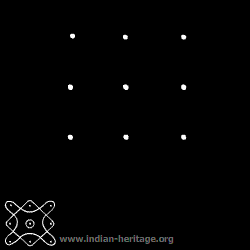Working With Shape: Kolams and Lusona
Title
“Need somthing here”
—
Introduction
The South Indian tradition of Kolam, and the Angolan tradition of Lusona art have quite a few things in common. Both are also strongly linked to finite grammars and networks.
Click to generate a fresh Kolam!
Creating Kolams
How do we create these Kolam Patterns? Let us do this two ways: first pretending we are a South-Indian Woman adorning her doorstep in the morning. And then with two other methods, that lend themselves to computation / iteration. So, first by hand!
By Hand!
See if you can manually mimic some of the moves here! As an exercise, try to anchor your elbow and forearm to the table, and draw the pattern by rotating the paper! What are your observations?
Method #1: Using Canonical Pieces
Here we use “pieces of Kolam” that are standard: by repeated usage of combinations of these pieces, ( I believe ) any kolam can be produced. Here is a video showing kolams with a few canonical pieces:
Which are the canonical pieces here?
Method #2: Using Mirrors and Light
This follows the development of Paul Gerdes.
First let us get a printable grid to make our Kolams manually, since making grids can become tedious when you are making a lot of Kolams. We can use the grid to place “pulli-s” on the grid to make our Kolam. Head off to: https://editor.p5js.org/arvindv/sketches/UuHApkvqd and open it in your p5.js web-editor. Print out a few samples of the .svg grid file that is generated.
Now consider that each of your Kolam “lines” or “trajectories” is made of light. And place some single horizontal or vertical mirrors, at some locations midway between adjacent pulli-s. See the figure below:
The black lines here are to be imagined as “made of light”. Whenever they hit a mirror, a “curved reflection” occurs. Note how the arrangement of mirrors is symmetric here. Can we take computational liberties here and make asymmetric mirror arrangements? Can the grid also be non-square? Try?
For more inspiration, see here. This is a multipage article with many different grid+mirror arrangements! There is also an intriguing technique shown therein of colouring the squares in the grid alternatively white and black, to generate very symmetric shaded patterns!
Kolams in p5.js
This is also the idea embedded in this toy called Kolam Tiles.
Kolams in R
Some kolam like patterns for inspiration. https://www.pinterest.com/gbenainous/p5js-teaching-ideas/
Dr. Gift Siromoney’s webpage. https://www.cmi.ac.in/gift/Kolam.htm
Mirror Designs and Mirror Curves: Comparing Kolam and Tchokwe Art. https://www.mi.sanu.ac.rs/vismath/paulus/pg1.htm
YANAGISAWA, Kiwamu & Nagata, Shojiro. (2007). Fundamental Study on Design System of Kolam Pattern. {Available Online](https://www.researchgate.net/publication/237442288_Fundamental_Study_on_Design_System_of_Kolam_Pattern)
Paulus Gerdes. Lunda Geometry: Mirror Curves, Designs, Knots, Polyominoes, Patterns, Symmetries. https://www.sahistory.org.za/sites/default/files/archive-files3/paulus_gerdes_lunda_geometry_mirror_curves_desbook4you.pdf
Visual Mathematics. Mathematical Institute of the Serbian Academy of Sciences and Arts. Editor: Ljiljana Radovic. ISSN: 1821-1437. https://www.mi.sanu.ac.rs/vismath/
Imaginary.Org. Frozen Light App. https://www.imaginary.org/program/frozenlight
Ascher, M. (2002). The Kolam Tradition: A tradition of figure-drawing in southern India expresses mathematical ideas and has attracted the attention of computer science. American Scientist, 90(1), 56+. https://link.gale.com/apps/doc/A81528419/AONE?u=anon~274c1208&sid=googleScholar&xid=4105e718
















